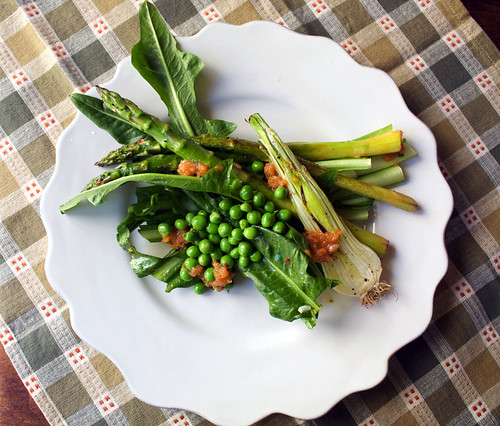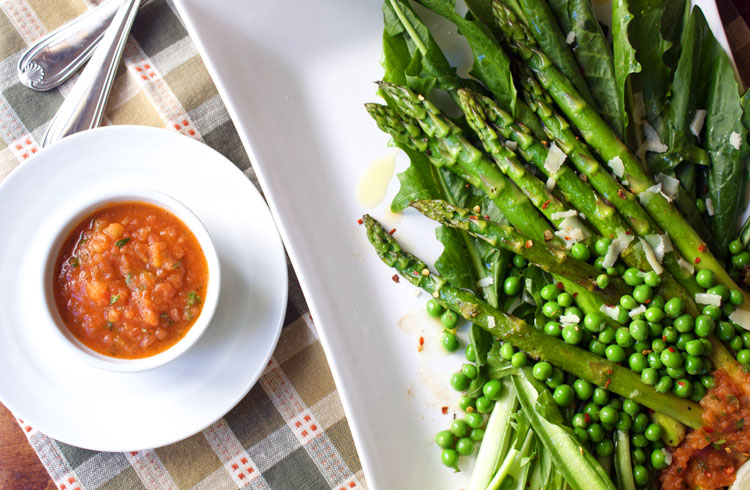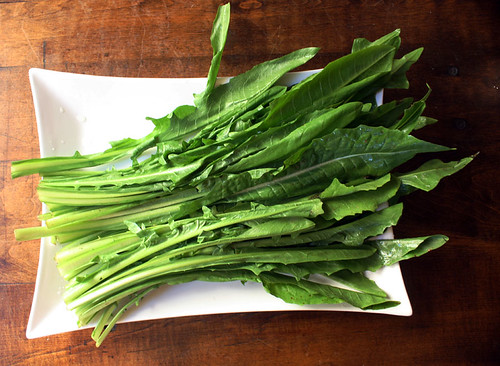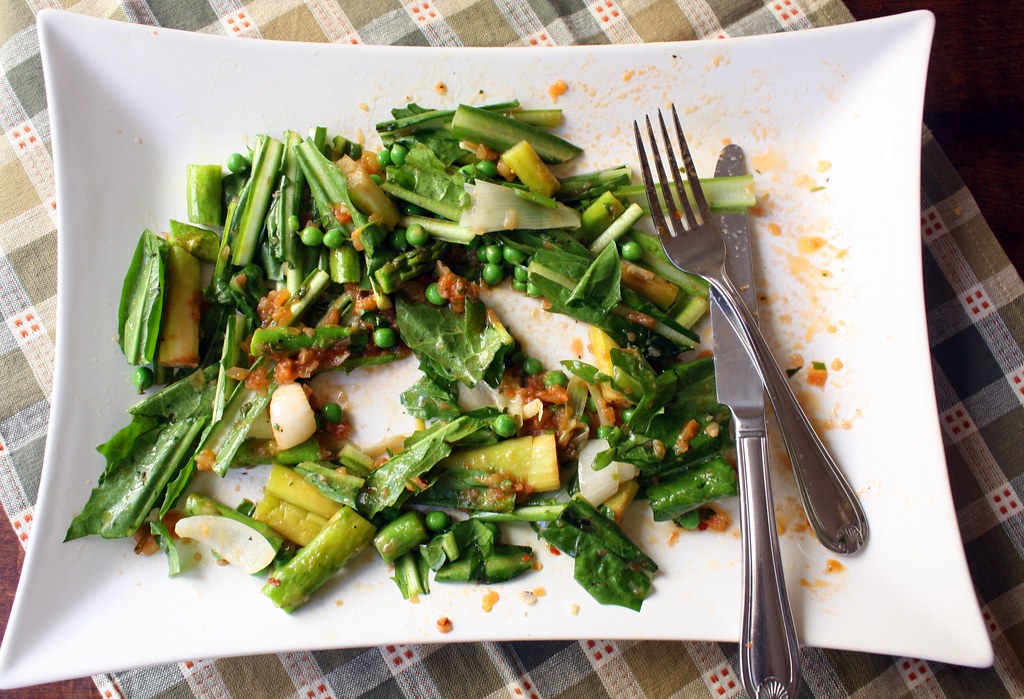Spring Salad with Dandelion Greens, Asparagus and Fresh Peas
If there was ever a salad season, Spring would be it. Baby veggies and greens are everywhere and the simple act of opening a food magazine has me craving salad more than I normally do. I’ve never lived above the 36th parallel north in my life, so I could argue that it’s salad season all year long, but I’ve concluded others may not necessarily feel that way.
Having spent the last couple of years learning more about people’s food preferences on the web, I’ve begun to understand that many would rather gaze at a piece of cake than a salad — or any vegetable, for that matter.
What is it about vegetables? Is it the pervasive greenness? The sometimes startling flavor of certain varieties? Or, is it more a childhood of over-cooked, badly seasoned peas, canned greens, and worse, wilted salads of flavorless iceberg lettuce drowning in bottled thousand island salad dressing, and peppered with a few bland pieces of tomato long stored in the vegetable bin of a fridge?
I say all of the above. Thankfully, I escaped it all — except at school when I was served the ubiquitous sage colored canned peas, forcefully spooned on the plastic tray by one of the less than friendly cafeteria ladies. I’d stare at those peas after finding my place at one of the long benches and hear my step-father’s voice telling me that I had to clean my plate because there were people starving in the world out there, and I was fortunate to have food to eat.
But I’d leave those peas on my tray. I’d leave them because they weren’t fit for human consumption, and I’d be surprised if any of the nutritional value originally in them was left at all. Besides, nobody at home would know I joined all the other kids in dumping them in the trash before running out to recess.
Thankfully, my mother avoided canned peas in our home meals, opting for frozen instead. And salads were routine so it’s no surprise that I love my veggies even if my younger sister mysteriously didn’t — minus the peas my mother used to spoon directly onto her tray. They were one of the only kinds of food she liked! With each passing year, I look forward to what new ingredients are featured, or interesting combinations that will make my salads a meal in themselves.
My husband and sons refer to my salads as “feed” but eat them without complaint. Maybe it’s because I’ve worked hard to teach them what nutrients the greens and brightly colored veggies in that bowl contain, and how those nutrients affect their bodies and overall health. Or maybe it’s because they’re just plain good.
Have you ever had dandelion greens and fresh English peas in a salad? Add some lovely asparagus and a Gordon Ramsay tomato vinaigrette and dinner is served.
My taste buds sang all night long… 
Spring Salad with Dandelion Greens, Asparagus and Fresh Peas
Salad Ingredients
1 bunch dandelion greens
1/2 bunch large asparagus, bottoms trimmed and shaved
1/2 c. fresh peas
1 spring onion, halved lengthwise
extra virgin olive oil
sea salt
fresh cracked pepper
shaved Parmesan
Dressing Ingredients
2-3 ripe roma tomatoes, peeled, seeded, and diced
1/2 c. extra virgin olive oil
1 shallot, minced
juice of 1/2 lemon
1 tsp. good balsamic vinegar
1/2 c. flat leafed parsley, no stems
Directions:
- Rinse the dandelion greens, and if necessary, remove any coarse stems. Allow to dry on a clean towel and then arrange on a large platter. Drizzle with some extra virgin olive oil and set aside.
- Prepare the asparagus by removing the woody portion of the stem and using a vegetable peeler to scrape away all the skin below the tips. Drop the asparagus in a few inches of rapidly boiling water for 1-2 minutes depending on the thickness of the asparagus, and then lift out to douse in an ice bath to stop the cooking. Retain the cooking water for the peas. Remove from the ice bath when completely cool, allow to dry on a clean towel, then place on a platter and sprinkle with a tablespoon of extra virgin olive oil and a sprinkle of sea salt and some fresh cracked pepper.
- To prepare the peas, use the same hot water to blanch the peas, allowing to cook in softly boiling water for 3 minutes. Retain the cooking water for the tomatoes. Remove and douse in an ice bath, then remove to a clean towel to drain.
- Prepare the onions by placing them on a parchment lined baking sheet and sprinkling them with olive oil, salt and pepper. Place them under the broiler until they begin to brown. Remove from the heat and set aside.
- To prepare the tomatoes, bring the pan of reserved water back to the boil and place the tomatoes in the pan. Allow to sit for about 1 minute, then remove to an ice bath. The skins should be easy to remove and discard. Cut the tomatoes, remove the seeds and membranes, then dice the remaining meat.
- In a small skillet, heat the 1/2 c. olive oil and shallots over low heat until they begin to soften, about 10 minutes. Pour in the lemon juice, balsamic vinegar, and tomatoes, increasing the heat and cooking about 5 minutes until tomatoes are soft. Pour the mixture into a food processor or blender and pulse until pureed. Season with salt and pepper and cover to keep warm.
- In the same skillet, turn the heat to medium high and add the prepared asparagus. It should sizzle in the pan when you add it. Allow to cook 2-3 minutes, turning it to make sure all sides begin to brown slightly. It should be crisp but tender when done.
- Arrange the asparagus over the dandelion greens and add the peas and broiled spring onions. Spoon some of the warm tomato vinaigrette over, and shave a bit of Parmesan as well.
- Pass around additional vinaigrette if desired.
A printable version of the recipe can be found here.
Recipe Notes:
- Chris of Mele Cotte is hosting her 3rd year of “Cooking to Combat Cancer” and this salad, along with many other recipes I’ll share during the month of April, qualifies. The deadline to submit something is April 29th, so please take a bit of time to get the information from Chris’ site and consider getting involved. The more we understand how much fresh fruit, vegetables, and other food can help fight certain types of cancer, the better we’ll all be.
- The tomato vinaigrette is based on one from Gordon Ramsay’s 3-Star Chef. It’s light, and lovely, and oh so fresh. Easy to make, too. Ramsay uses basil in his version which I’ve also tried and love. Either way, it’s worth making. It’s also perfect for dipping crusty bread into. I’m thinking that it would be lovely with a bit of pasta.
- Many thanks to Specialty Produce in San Diego for my dandelion greens. Like many other greens such as mustard, endive, kale, chard, and spinach they are a super source of folate, a form of vitamin B important to cell health. Some research studies have shown that diets low in folate have an increased risk of breast, pancreatic, and colon cancer. They’re not cruciferous (like kale, cabbage, and broccoli…) however, which all provide even more benefit to our bodies. There is an amazing amount of information available on the health benefits we can experience if we eat dandelion greens — more so than I could begin to mention here. Take some time to search yourself — I promise you’ll be amazed.
- Asparagus is also an excellent source of Folate as well as vitamins K, C, A and B1, B2, B3, and B6. Its list of general health benefits is equally staggering as that of dandelion greens. There are some interesting studies that suggest that asparagus could affect the development of lung and skin cancer.
- Many thanks to Specialty Produce for my beautiful fresh peas. Peas are a legume, so are a good source of protein. Like asparagus and dandelion greens, they’re also a good source of Folate as well as vitamins C, B6, and niacin. And I have to eat crow now, because evidently, the nutritional value of the dreaded canned pea is nearly similar to that of fresh. Unbelievable.
- Spring onions (also courtesy of Specialty Produce…) Onions, like garlic, are a member of the allium family and purported to be beneficial in reducing the risk of stomach and colorectal cancer.
- Tomatoes contain an important phytochemical called lycopene which is known to have an effect on the risk of developing prostate cancer. Although studies have shown the effect to be more positive if the tomatoes are cooked, tomato products in general are beneficial.
To make sure you enjoy every healthy aspect of this salad, go ahead and mess it up a bit. Then dig in!



